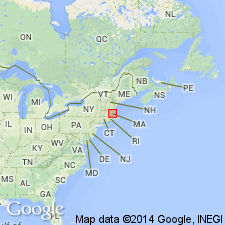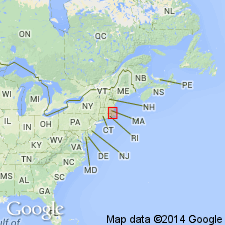
- Usage in publication:
-
- Fitchburg Complex*
- Modifications:
-
- Revised
- Redescribed
- Age modified
- Geochronologic dating
- AAPG geologic province:
-
- New England province
Summary:
Fitchburg Granite, defined by Emerson (1917) as two-mica granite with subordinate granodiorite, has been subdivided by most workers into gneissic and nongneissic phases, and as mapped may contain rocks of several ages. Name is therefore changed to Fitchburg Complex. U-Pb and Rb-Sr radiometric age determinations by R.E. Zartman and R.S. Naylor (1978, written commun.) indicate that granite of the Fitchburg is Early Devonian or younger.
Source: GNU records (USGS DDS-6; Reston GNULEX).

- Usage in publication:
-
- Fitchburg Complex*
- Modifications:
-
- Overview
- AAPG geologic province:
-
- New England province
Summary:
Used as Fitchburg Complex. Age is Early Devonian or younger. Divided into: muscovite-biotite granite, muscovite-biotite granite to granodiorite gneiss, biotite granodiorite to tonalite gneiss, biotite granodiorite to tonalite gneiss containing many zones of foliated biotite gneiss, and biotite granodiorite to tonalite gneiss containing inclusions of tonalite.
Source: GNU records (USGS DDS-6; Reston GNULEX).

- Usage in publication:
-
- Fitchburg Complex*
- Modifications:
-
- Overview
- Geochronologic dating
- AAPG geologic province:
-
- New England province
Summary:
Fitchburg Complex mapped as three small stocks intruding Worcester Formation east of Wekepeke fault and west of Clinton. Also intrudes Paxton and Littleton Formations. U-Pb zircon age of 390 +/-15 Ma and Rb-Sr whole-rock age of 402 +/-11 Ma were both reported by Zartman and Naylor (1984). [Papers presented as chapters in U.S. Geological Survey Professional Paper 1366 are intended as explanations and (or) revisions to MA State bedrock geologic map of Zen and others (1983) at scale of 1:250,000.]
Source: GNU records (USGS DDS-6; Reston GNULEX).
For more information, please contact Nancy Stamm, Geologic Names Committee Secretary.
Asterisk (*) indicates published by U.S. Geological Survey authors.
"No current usage" (†) implies that a name has been abandoned or has fallen into disuse. Former usage and, if known, replacement name given in parentheses ( ).
Slash (/) indicates name conflicts with nomenclatural guidelines (CSN, 1933; ACSN, 1961, 1970; NACSN, 1983, 2005, 2021). May be explained within brackets ([ ]).

